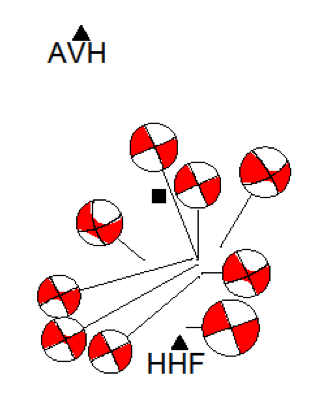What we offer
Microseismic array design and project management
The successful collection of microseismic data requires careful consideration of array design prior to deployment, maximising detection thresholds and event location accuracy. There are several types of monitoring array that can be deployed (e.g. single well, multi-well, surface network, shallow borehole array).
The choice of monitoring method is dependent on what the microseismic data is needed to do, as well as logistical constraints specific to each operation.
If you are new to microseismic monitoring, or if you need assistance from independent experts to design and set up a microseismic monitoring system, we are here to help. We have considerable experience with the different styles of microseismic acquisition, and are familiar with their respective advantages and weaknesses. We use full-waveform simulations to model detection thresholds and location accuracies, optimising the quality of data provided by your monitoring array.

Induced seismicity and baseline monitoring

Oil and gas regulators around the world are recognising the potential signification of induced seismicity for extractive operations. Increasingly, regulations are being applied that require operators to (i) characterise historic levels of baseline seismicity in an area prior to operations, (ii) assess the seismic hazard posed by proposed operations, and (iii) to monitor seismicity during operations, with operational decisions being made based on the seismicity observed.
We have extensive experience deploying seismometers and monitoring natural earthquakes around the world, often in very challenging environments. We can bring this experience to address current concerns about induced seismicity in energy technologies, helping to ensure that operations are conducted safely and responsibly, and that operators are able to comply with all induced seismicity regulations,
Post-processing, quality control and interpretation
Have you acquired microseismic data, but you aren’t sure of the event location quality, or how to interpret it? We are here to help: we can review, reprocess and reanalyse microseismic datasets, providing independent assessment of event locations and their reliability. We can assist your interpretation of microseismic data – what do those dots in the box mean for the success of your operation? Moreover, we have pioneered the use of state-of-the-art techniques to get more from your data than dots in a box alone, and can apply these methods to your dataset.

Training

The use of microseismic methods to image deforming and fractured hydrocarbon reservoirs is a novel but rapidly growing technology. Could your company stand to benefit from an improved understanding of these techniques?
With respectively 30 and 15 years teaching experience at top-level U.K. universities, we offer workshops and in-house training, covering microseismic monitoring and induced seismicity from the basics through to the latest state of the art. Our taught courses can be tailored to your needs, both in terms of course length, and the level of previous knowledge assumed.
Powered by w3.css